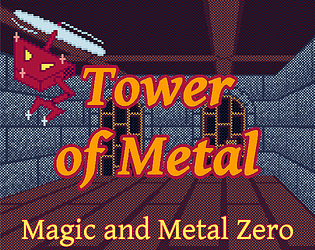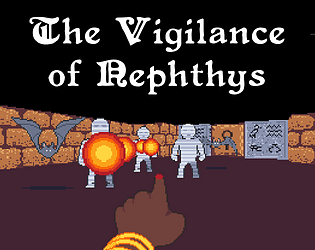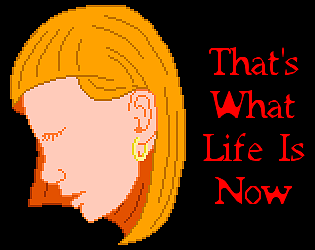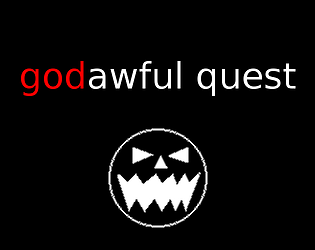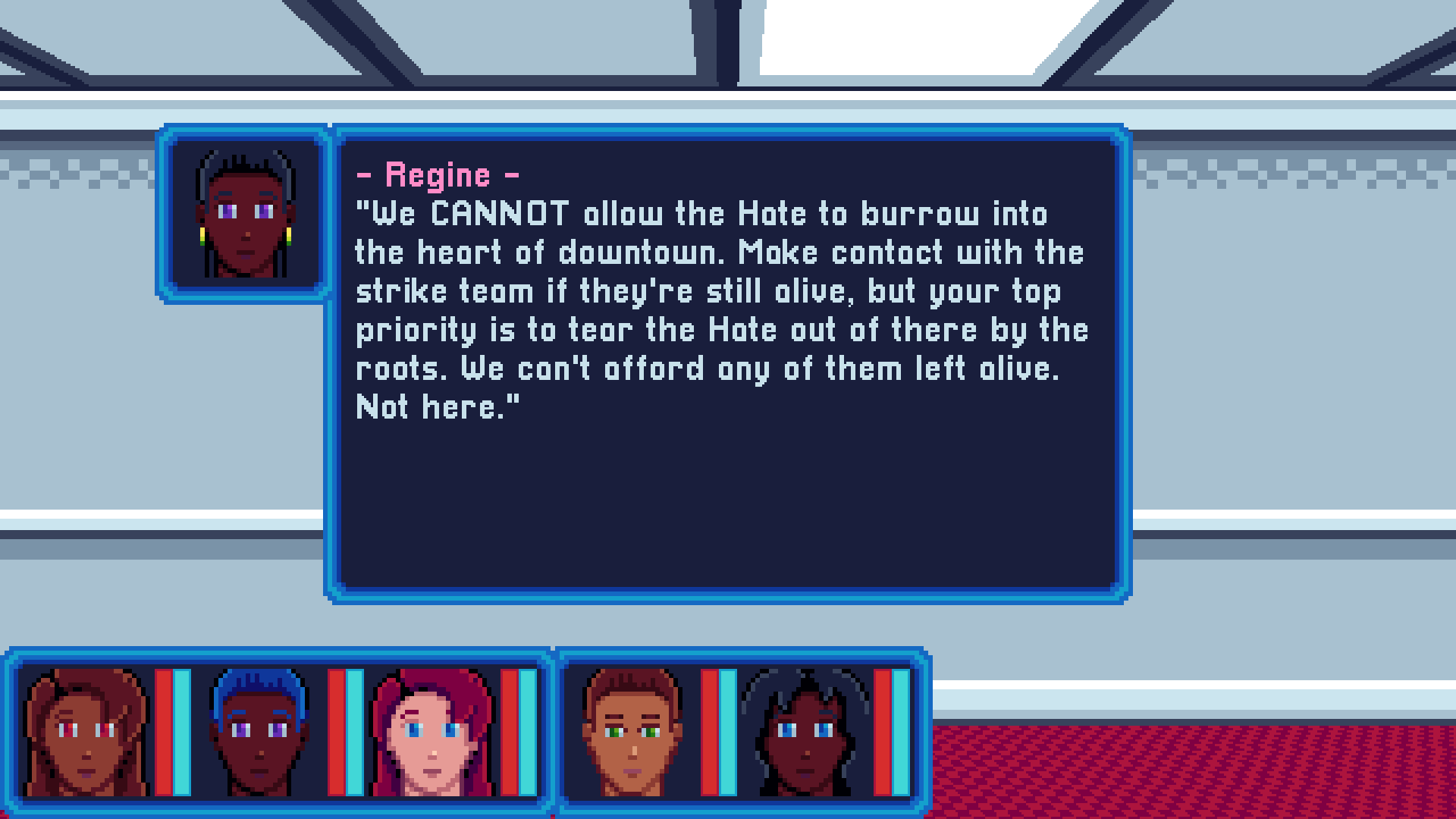Very cool updated take on the Secret Agent style of platformer. Great job.
Midnight Spire Games
Creator of
Recent community posts
Hi, sorry for the delayed response. The dark effect is a group of quads arranged around the player with a dithering shader applied, and a solid black one at the furthest distance. When layered on top of each other, they create the effect of diminishing light. They move with the player, but do not rotate.
I tried using stock lighting effects for this, but it just didn't give the effect I wanted.
Cute and bite-sized, just in time for ghost season. I wish it was longer, as it felt a little abbreviated towards the end, but you fit a lot into the jam period.
I liked the little bit of interactivity as it gave the experience a bit more bulk. I particularly enjoyed browsing the ghost wiki. This added a lot more interest than plain narration.
The art is cute and very clean, and the ghost being totally silent was a nice touch. I did think it was a little odd that Penny Bun always seems to have the lights turned off, but it's spookier that way.
I disagree that this is a cost-saving fad from big-money publishers, or even a fad at all. It was very common if not the norm for many years across many genres, especially when storage space for frivolous text was severely limited, and digitized speech was an expensive novelty that sounded terrible anyway. Over the years, text became trivial to include, while voice acting is still expensive. If anything, protagonists that speak have become more common since the early days, not less, especially in games that aren't fully voiced. There's no real financial incentive not to write some plain text; it's done for stylistic reasons. Meanwhile, in fully-voiced games, you may have the budget to voice, say, 500 lines of dialogue; the pressure here is to keep the total script to 500 lines, not to silence the protagonist specifically. At most, doing so might be marginally convenient. It certainly isn't a bullet point feature to boost sales.
I don't see any evidence that there has been a large-scale shift in the industry towards protagonists who should speak no longer doing so. That's a very strange claim to make.
Have fun. The key to staying motivated on your game project long term is to make a game that you want to play. Don't let others kill your motivation by suggesting game mechanics and features that you're just not interested in.
I want to expand on this, because it's important to look at feedback the right way. I use two rules of thumb:
1) When it comes to things like accessibility, usability, clarity of instruction, interface design, display and input compatibility, and things like that, listen to your users. That doesn't mean you have to do everything they say, but you should at least pay attention to it, because user experience tends to be a big blind spot for developers. You understand your application inside and out, but your players don't. It's also natural to design around our own capabilities and not fully consider what others need or prefer.
2) When it comes to mechanics, gameplay design, writing, art style, and so on - all the creative aspects - consider feedback carefully. Ask yourself "is this actually a weak spot that I can improve on?" or "if I make this change, will it bring me closer to my design goals, or not?" If the answer is yes, then it's probably a good idea. If the answer is no, you should probably ignore it. It's your game, so make it the way you want. That doesn't mean that all of your own ideas are automatically the best ones, it just means that you need to filter out feedback that won't help you achieve your goals.
Keep a to-do list. Any time you think of something you want to add or fix but can't do it right away, write it down, or create an issue in your repository. Come back to it when you're ready and check it off. Not only is this a good way to keep track of what needs doing, but checking things off is satisfying and good for motivation. You'll also waste less time thinking "what should I work on next?" because you'll always have plenty of answers right at hand.
Also, one very underrated game development tool is pencil and paper. If you are stuck on a design or math problem, or just need to brainstorm content ideas or draft a new level, try stepping away from the computer and sitting down somewhere else to work it out on paper. I like to sit on my bed with a clipboard. I find this to be the most intuitive way to work through my thoughts and decide on an approach. Scribbling on paper is much more free-form than working in Notepad or Excel, and it removes all the distractions of your code and development applications.
I also often do this when designing new enemy sprites or certain other kinds of art. I like to sketch the image by hand with drawing pencils, then scan it in and use the sketch as a basis for the pixel art. I get better results this way than trying to pixel from scratch. For my current project, a dungeon crawler, I always design and annotate levels on grid paper first. The maps for this game are too complex to just freehand in Unity and expect them to turn out well.
Hi, I'm sorry you found this frustrating. I hope you were able to move forward in the mean time using the solution provided in the manual, but I am happy to explain the logic behind it. (Spoilers below, for anyone else reading.)
------------------------------
The first clue (found in Clocksworth's study) is "The path of the travelers leads to higher ground," meaning that you're meant to trace the route that the travelers took and orient the statues accordingly. You don't have to move the statues in a specific order, but the direction of their travels informs the clues, and it's easiest to work them in that order.
So, where do we start? All of the clues reference multiple travelers except one: "The dryad left home to visit her friend, the sprite." Therefore, we know that the dryad started out alone before being joined by the others, so we'll start with her. The sprite statue is east of the dryad, so we know the dryad is traveling east - so, we turn the dryad statue to the east.
The next one is probably the trickiest part. There are two travelers at this point (the dryad and the sprite), standing at the sprite's location, and there are two clues that reference two travelers: "The crocodile chased two travelers beyond the castle grounds" and "The jester joined two travelers who were heading to the city." All other clues reference three travelers, so we ignore those for now. Note that the crocodile is immediately south of the sprite, whereas the jester is all the way in the southwest corner. Because of the clue "The gargoyle greeted three travelers as they arrived at the castle," we know that the gargoyle represents the castle. The gargoyle is one position west of the crocodile, whereas the jester is two positions west of the crocodile. There is no clue that explicitly mentions what the dryad and sprite did after meeting up, but we know that only two travelers encountered the crocodile. Between this and the fact that there is nothing east or north of the sprite, we can conclude that they traveled south to the crocodile from the sprite's location, so we turn the sprite to the south. We also know that the crocodile chased the two all the west, beyond the castle, so we turn the crocodile west. Because the travelers went beyond the castle, and because the gargoyle met three travelers and the jester met only two, we leave the gargoyle for later and move on to the jester.
The jester's clue is "The jester joined two travelers who were heading to the city." From the clue "The soldier shielded his eyes from the sun as he watched three travelers depart the city," we know that the soldier represents the city, and the soldier is two positions north of the jester. Since we know that the jester is headed to the city, we turn the jester north. At this point, the travelers are the dryad, the sprite, and the jester. All of the remaining clues reference only three travelers, so no one else will be joining them.
Next, the soldier. Since he is shielding his eyes from the sun while watching the travelers, we can assume (based on Earth logic, at least) that the travelers are headed either east or west - towards either the sunrise or sunset. Since there's only a wall to the west, we know that the travelers aren't going that way, and so we turn the soldier to the east, towards the merchant.
The next clue is "The merchant turned away from three travelers as they crossed the empty field." The merchant is the north center statue, and the empty field refers to the empty space in the center of the room (we also know that the only remaining clue indicates that the travelers at some point went to the castle, which is directly south of the merchant at the gargoyle's location). To cross the field, the travelers must head south, so we turn the merchant in the opposite direction - north.
The final clue is "The gargoyle greeted three travelers as they arrived at the castle." Based on the merchant's clue, we know that the travelers are arriving from the north. To greet them, the gargoyle must therefore be facing north.
The final path of the travelers looks something like this:
5 -> 6 | | 1 -- | -> 2 | | | 4 <- 7 -- 3
------------------------------
I hope this helps you make sense of the solution.
I noticed a problem: Many, I really mean "the most", stay solo on developing. Why is it that way? There are indie devs who invested months and years into ONE single project. Wouldn't it have been easier when the devs form a group.
I work alone mainly because I don't want to argue or compromise on what I make. Working alone means I can make only what I want to make, and I can make it however I please, without having to convince anyone that it's the right decision. I also want to work at my own pace without other people depending on me, or me having to depend on them.
Unfortunately, working alone is also exhausting and demoralizing, but to me it feels like the only option.
You prove a good point that caring about numbers is a bad thing and that I should focus more on individual people, but dude I don't even have that. People on my Reddit posts just say it looks cool, like bruh can you play the game please?
Is there a formula that makes games blow up, or at the very least have some YouTubers cover the game and give live feedback?
You've already discovered the formula: meme horror games. I count a total of twenty-six gameplay videos linked from the comments of your other three project pages, mostly for the two Siren Head games. That's a lot. When a YouTuber runs a generic search for "siren head" looking for something to entertain their audience, they will find your games in the list. Your original tower defense project will probably not get the same level of attention as those.
A feedback circle probably works for short-form games, but something like my last release, which is a long-form game in a niche genre, is still not really going to get the kind of feedback that it would most benefit from. It requires too much engagement, and it would not be reasonable for me to expect that from people.
but countless times I feel like my dating sims are good at first, until I trash out my idea and the cycle starts all over again.
It's probably not trash. It probably just needs refinement.
I'm not much of a writer, so I don't have any advice on how to get better at writing, other than practice. If you are anything like me, though, you need to not just write, but rewrite.
My first attempt at a scene or conversation usually isn't great. That's OK, though. I just do the best I can in the moment, which I may or may not be happy with. Then I move on to something else. When I come back to that section later and reread it, I might think it's awful and despair that I wrote something so bad, but I will see ways to improve it, so I rewrite it. It's probably still not good enough, though, so I come back to it again later. Then I rewrite it again. I keep doing that until I have something satisfactory.
I am not talking about proofreading (although that is mandatory) but revising the text for better flow, better word choice, more natural dialogue, more evocative descriptions and so on. It takes a few tries to get it right. So basically, don't be discouraged if your work seems poor at a second or third look. Just keep going over it again and again until it's polished.
There are many, many ways you can do this depending on the complexity you need, but first you should know why that data isn't persisting currently. It sounds like you are assigning the player's name to some MonoBehaviour attached to a GameObject in the scene. You can do that, but (by default) when you unload a scene, every object in the scene is destroyed and its data is lost. Even if you have e.g. a copy of the same prefab in every scene, each one is still a separate object with its own state.
A simple way to do this would be to create a ScriptableObject containing variables for the player's name and whatever other persistent data you need (health / ammo / etc) and set the values there. Then anywhere you reference that ScriptableObject in the application, you will see the same values, because there is only ever one copy of a ScriptableObject and it is not tied to a scene. To get the data to persist after closing the game, you would have to write those values to a file when the player saves the game, then read them from the file when the player loads the game.
I just keep in mind that nobody really cares what I'm doing. Publishing is an act of completion for myself more than for anybody else, like framing a finished painting before putting it away in the attic. From that perspective, there's nothing for me to be afraid of. Obviously I hope someone enjoys my work from time to time, but if not, I made something that I wanted to make and passed another milestone on the journey to making better games.
Another point I would like to add is that if he had changed his mind he would have noted it directly in the video. If I made something I did not like no matter what I would tell people "I do not like making games of this genre, I will try to build something else that is more of my style", but in the video he still calls his finished product a Roguelike. So, the original idea was to make a Roguelike, his final idea was still to make a Roguelike, he did not have a change of mind in this regard. The only change of mind, maybe, was that he dropped the puzzle aspect of his game which is something he mentioned early in the video, but something that he did not follow through.
You still seem to be saying that this person just picked an arbitrary label that they didn't really understand, then worked backwards to arrive at a product that they thought fit the label. That doesn't make sense to me. Something about roguelikes evidently piqued their interest, but if they were really committed to making a turn-based, tile-based RPG, they would have. They wouldn't have scrapped that design and made a twin-stick shooter instead, just because they saw that some of those are labeled "roguelike." I can't see how tighter application of that label by other developers would have prevented any genre drift by this one. They might have just gone further afield for inspiration before finding something they liked. Games create genres, not the other way around; genres are just a shorthand in how we talk about games.
Moreover, the developer could very well have made such a change without ever seeing those other games. Did you know that Diablo 1 was originally a turn-based game? It evolved into real-time combat later in development. This despite that Blizzard North explicitly cited Rogue itself as an inspiration for Diablo.
Why would they? Didn't you say it was a theme, not a genre?
To me it is. Sometimes it's useful to loosely indicate a genre, but it can really be any sort of game.
I am actually curious now, what do these people consider a game to be a dungeon-crawler? Perhaps it is something I'd like to play too.
Sure. Here you go. This is a very strict definition that largely limits the term to only the most traditional Wizardry and Dungeon Master descendants. By this definition, Might and Magic III is a dungeon crawler, but Might and Magic VI is not.
I don't really agree with the lines drawn there, but it goes to show how subjective genre labels can be.
In a nutshell, the developer was developing a Roguelike, but because it did not pan out the way he intended to, he got inspired by games he found on Steam to make another quote-on-quote "Roguelike", wrongfully thinking he was still developing a Roguelike and that misconception came from a spread-out misinformation that still gets perpetuated to this day.
You are saying that you expected an authentic traditional roguelike experience from a developer who, by your own account, doesn't even know what a roguelike is.
What seems to have happened here is that the developer did not like what they were making, so they made something else instead. You seem to be suggesting that the reason this happened is that language is insufficiently prescriptivist, and not that the developer just saw something they liked better and changed their mind.
Secondly, this asinine problem makes it harder for me (and other people like me) to find games that I like, thankfully the Dungeon-Crawler tag still works and that is the only way I can still find Roguelikes on gaming sites such as Steam, Itch and Gamejolt.
I don't see why that would be the case. Not all dungeon crawlers are roguelikes, not even close; and roguelites are probably almost as apt to be labeled dungeon crawlers as roguelikes are, given that dungeon crawling is typically considered a theme, not a genre.
I decided to try this out for myself. Both The Binding of Isaac and Slay the Spire, which you keep bringing up as undesirable, are tagged "dungeon crawler" on Steam; in fact, when I browse the dungeon crawler tag on Steam, both of those games are prominently displayed in the banner at the top of the page. Glancing over the actual recommendations, I see a handful of traditional roguelikes, as is expected, but I mostly see other genres. If I were actually looking for roguelikes in this list, I would probably be disappointed. The roguelike list is, as you say, a mix of roguelikes and roguelites, but it looks more promising than the dungeon crawlers.
Filtering my own Steam library for dungeon crawlers, I see JRPGs, action RPGs, first-person shooters, arcade games, puzzle games, board games, a platformer, and more. Few of these are what I would actually want to see when searching for dungeon crawlers.
If you still find the dungeon crawler tag a reasonable and effective filter for roguelikes in spite of all that, then why do you find the roguelike tag so unusable? I sympathize with your difficulty in finding what you want, but most highly specific sub-subgenres do not have a commonly agreed-upon label at all, let alone one as precisely defined (if frequently misapplied) as "roguelike." All anyone has to meet their specific tastes is an approximation, which then has to be sifted by hand. It isn't just roguelikes.
By the way, I know of folks who would take umbrage at grouping traditional roguelikes in with dungeon crawlers. To them, dungeon crawler is a term with a very specific, long-established meaning (which does not include Rogue) that has been diluted into uselessness, making it difficult to find the true dungeon crawlers amongst all the mislabeled pretenders.
Nevertheless, while language is subjective, it needs to serve its purpose. I can not imagine how a conversation between a fan of Rogue and a fan of Isaac would go like when the term that even link these 2 games together have different definitions, the other of which is wrong
Why can you not imagine it? I would think that they would discuss the games themselves, rather than being confused and deadlocked over a label. I can't remember ever having that problem.



